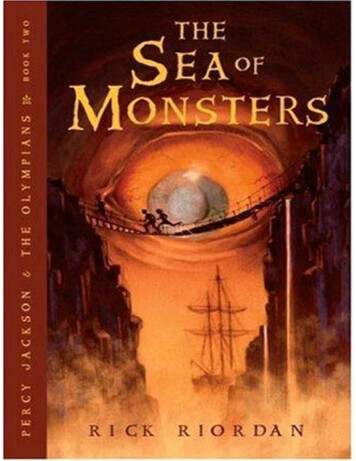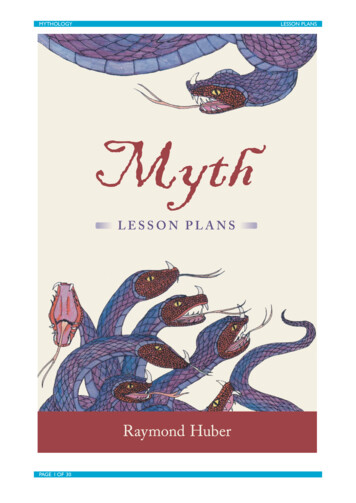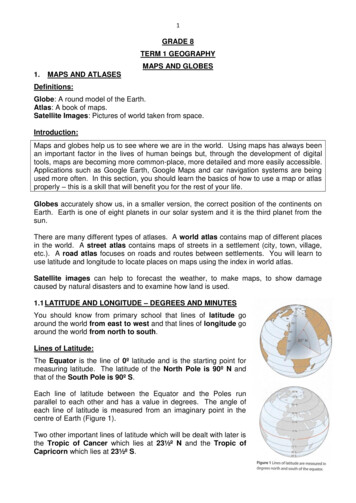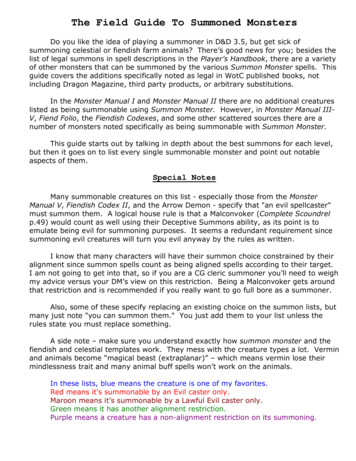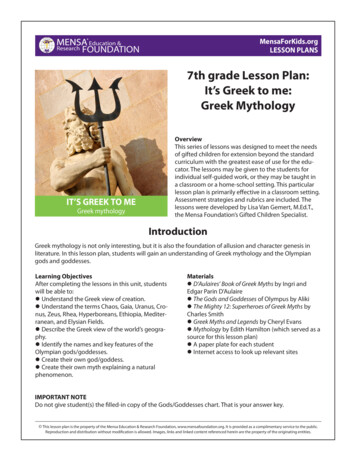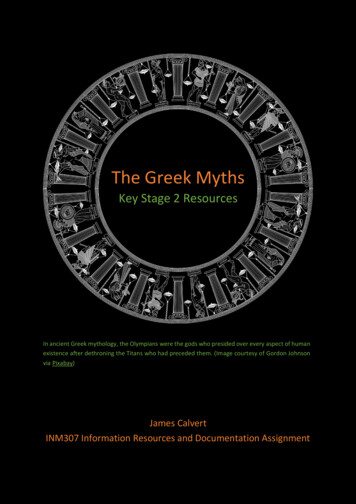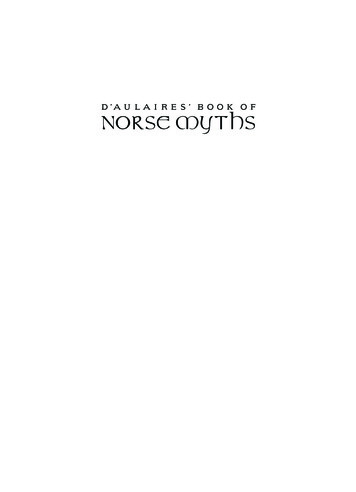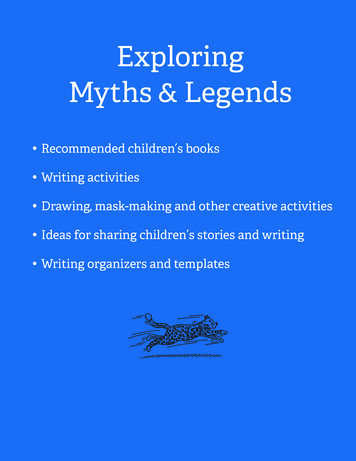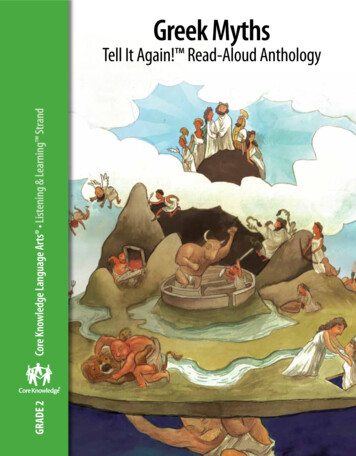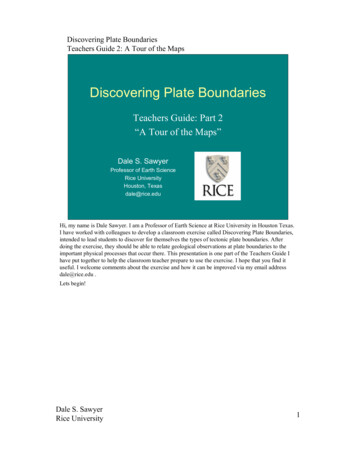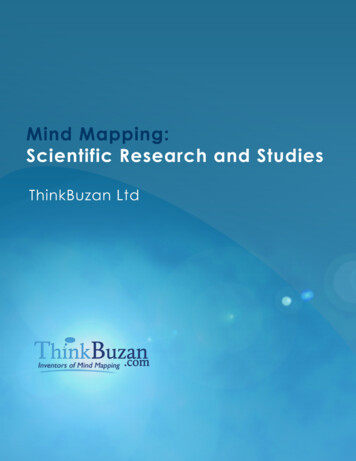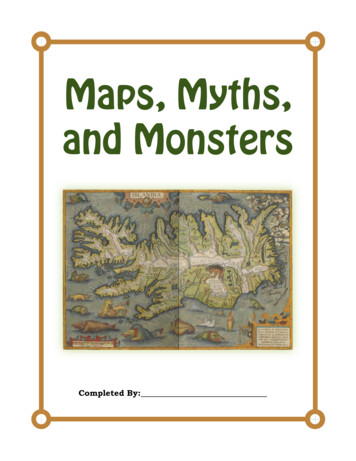
Transcription
Maps, Myths,and MonstersCompleted By:
1IntroductionWhen Sebastian Munster was making maps in the early 1500s, hewanted to include pictures of people and animals from far away. ButMunster didn’t have photographs or the internet to help him-- insteadhe had to rely on stories from explorers and very old books for hisinformation.Munster lived during a time period we call the Renaissance, which lastedfrom about 1450 to 1600. Europe was discovering a lot about the worldduring the Renaissance, but there was still a lot that theymisunderstood.Directions:Find the following images of mythical characters and creatures on theRenaissance maps and illustrations provided. Make sure to note theitem numbers when you find the images.Part One: MythsMyths are stories that include supernatural beings or events in order toexplain how nature, ideas, or practices came into existence.Medieval MythsIn the Middle Ages, people were taught to believe that the only source of truth was theCatholic Church. Even though map people during the Renaissance began to believethat science and logic were the keys to knowledge, many medieval myths were stillwidely accepted.1. If you asked most Europeans during the Middle Ages howhuman beings came to exist, they would likely tell you thestory of Adam and Eve, found in the Book of Genesis, whichis included in the Bible. According to Genesis, the first man,Adam was created from dust by god. The first woman, Eve,was created from a rib of Adams. In the Medieval worldview,all human beings are descendants of Adam. Find this imageof Adam and Eve. What item is it found on?
22. According to Genesis, Adam and Eve were kicked out ofthe Garden of Eden, where they did not have to have to workfor food, after they ate of the Tree of Knowledge of Good andEvil. Many medieval Europeans believed that the Garden ofEden was hidden in the Far East. Find this image of theGarden of Eden. What item is it found on?3. Europeans in the Middle Ages only knew about threecontinents: Asia, Africa, and Europe. According to Genesis,the entire world was killed in a flood, except for a mannamed Noah, his three sons, and their wives. A medievalscholar, the Venerable Bede, wrote that Europe was settledby Noah’s son, Japheth, while Africa was settled by his son,Cham (or Ham). Shem (or Sem), the third son, settled Asia.God’s chosen people, the Israelites, descended from Sem.Find this image of Sem. What item is it found on?4. One medieval myth stated that a lost tribe of Israel stillwandered the earth. According to prophecies, all of the tribesof Israel will be gathered together in the Holy Land(Palestine) near the end of the Earth. When explorersencountered Native Americans in the New World, many feltcertain that they were actually a lost tribe of Israel. Find thislist of Sem’s descendants in the New World. What item is itfound on?!5. Because Jerusalem was considered Holy, medievalEuropeans fought several wars for the Holy Land (includingJerusalem) with Islamic Turks. These wars are known todayas the Crusades. Jerusalem was often pictured at the centerof medieval maps. Find this image of Jerusalem. What itemis it found on?!6. Europeans during the Crusades believed that they wouldreceive help from an Ethiopian king, Prester John, who wassupposedly a Christian ruler of a large nation in Africa. Evenduring the Crusades, legends about Prester John hadalready been around for hundreds of years. While there aresome theories that he may be based on a 1st centuryChristian in Syria, no one knows for sure where the legendof Prester John came from. Find this image of Prester John.What item is it found on?
3Classical MythsWhen the city of Constantinople was captured in 1453, many of the old books from theGreeks and Romans were sent to Rome to keep them safe. Europeans had never readmany of the books, and they were amazed by the knowledge of the classical (Greek orRoman) writers. Classical culture became very popular throughout Europe, andmapmakers often put images of Roman myths on their maps.!7. In Roman mythology, three gods ruled different parts ofnature. While Neptune had power over the sea and Plutoruled the underworld, Jupiter was god of the sky. Thought tocontrol weather, he is often pictured holding lighting bolts.Find this image of Jupiter. What item is it found on?!8. While he didn’t control the underworld or the sea, Jupiterwas the most powerful of the three rulers. Often considered“king of the gods,” Jupiter is usually pictured wearing acrown. Occasionally, his wife, Juno, is also pictured withhim. Find this image of Jupiter and Juno. What item is itfound on?!9. The Greeks and Romans built elaborate structures inhonor of their gods. This gold statue of Jupiter wasconsidered one of the Seven Wonders of the ancient world.Find this image of Jupiter’s statue. What item is it found on?10. Jupiter’s statue is found in the Vale of Tempe, next toMount Olympus, where the gods were thought to live. Findthis image of Jupiter’s temple. What item is it found on?
4!11. Neptune is the god of the seas. He is often shown holdinga fisherman’s spear, called a trident. He was served byTritons and Nereids, the Roman name for mermen andmermaids. Find this image of Neptune. What item is it foundon?12. Ceres is the earth goddess, and is usually shown wearingor holding wheat. She was the god who most symbolizedsummer. The most famous story about her involves thekidnapping of her daughter, Persephone. When Pluto, god ofthe Underworld, captured Ceres’ only daughter, Ceres grewdistraught and caused a severe famine across the land. Findthis image of Ceres. What item is it found on?!!13. Apollo is the god of music. He is also considered the “sungod.” While he is the son of Jupiter, Apollo’s mother wasJupiter’s mistress and not his wife, Juno. Apollo spent manyyears trying to escape Juno, who was trying to have himkilled. Find this image of Apollo. What item is it found on?!14. Bacchus is the god of wine. Because winemaking wasdone in the fall, he came to symbolize autumn. He is usuallyshown holding grapes and accompanied by Satyrs, half-goatpeople. Find this image of Bacchus. What item is it foundon?!15. Venus is the goddess of beauty. She is often shown withswans, and is usually accompanied by Cupid, who someRomans thought was her son. Venus possessed a belt thatmade the wearer irresistible, and even lent it out to Juno soshe could distract Jupiter from the Trojan War. Find thisimage of Venus. What item is it found on?
5!16. Flora is the goddess of flowers. Symbolizing spring, sheis often shown holding bouquets. In one story about her, theWest Wind, Zephyrus, fell in love with her and followed hereverywhere she went. She distracted him by scatteringflowers behind her.!17. Pluto is the god of the underworld. He is best known forkidnapping his own niece, Persephone, and trying to makeher marry him.!18. Mars is the god of war, and is usually shown with ashield and sword. The Romans believed that Juno becamepregnant with Mars by eating a magical flower in order to getback at Jupiter for having so many children with othergoddesses. In mythology, Mars’ son, Romulus, founded thecity of Rome. FInd this image of Mars. What item is it foundon?!19. Saturn is best known for being the father of Jupiter. Heis often pictured with a scythe because he used one to attackhis own father, Uranus, at the request of his mother. Findthis image of Saturn. What item is it on?20. Even though Jupiter was considered the king of gods, he was not the oldest. Saturn is hisfather, and three of the gods listed above are his siblings. Determine which three with help fromthe following clues:- Persephone is Jupiter’s niece.- Jupiter’s own brother kidnapped Persephone.- Jupiter agreed to ruling the sky while his brother ruled the sea.
6Part Two: MonstersPart of the reason that Europeans were so impressed with classicalwriters was the knowledge the Romans had of amazing people andanimals in far away parts of the world. One very important book tomedieval and Renaissance scholars was the large encyclopedia by Plinythe Elder, which included many descriptions of what we would considermonsters today.Humanoid MonstersDuring the Middle Ages, people believed that humans could have children with animals,but that the children would be monsters. They also believed that strange “races” existedin the remote parts of the world.!1. According to classical writers, such as Pliny the Elder, atribe of humanoids could be found in Africa with giant lipsthat could be pulled up over their heads to provide shade.While the Romans called this race of humanoid “Amyctyrae,”they were probably based on a real group of Africans, theUbangi, whose women extend their lips by placing platesinside the skin.2. Another tribe found in Africa was the Cynocephali.According to many classical writers, the Cynocephali had thebodies of humans, only covered in hair, and a face thatresembles a dog’s. Known to live on raw meat, the they useda language that sounded like dog’s barking. When readingthe early accounts about the Cynocephali, it becomes clearthat the Greeks and Romans were mistaking Africanbaboons to be a tribe of humans. Find this image of aCynocephali. What item is it found on?!3. Satyrs were thought to be the children of humans andgoats. With the head and torso of a human, and the legs andfeet of a goat, Satyrs lived in the wild and loved to drinkwine. Find this image of a Satyr. What item is it found on?
74. The Blemmyae was another race of humanoids thought toexist in the remote parts of the world. They had no head, andtheir faces were found on their chest. Even Shakespearementions the Blemmyae in one of his plays. Find this imageof a Blemmyae. What item is it found on?5. When explorers returned from South America, there werereports of Blemmyae living in the inner parts of thecontinent. Find this image of South American Blemmyae.What item is it found on?!6. Mermaids were another kind of humanoid thought toexist. The Romans called them “Nereids.” Interestingly, manymedieval pictures of mermaids show them having two tailsrather than just one. Find this image of a Nereid. What itemis it found on?!7. Mermen were also thought to exist. They were calledTritons. Find this image of a Triton. What item is it foundon?!8. Centaurs were another kind of humanoid that manypeople during the Middle Ages thought existed. Like a Satyr,Centaurs were human from the waist up. Below the waist,they were horses. Find this image of a centaur. What item isit found on?
89. Many cultures have stories about fairies. While somebelieve that they are souls of the dead, others associate themwith nature. Find this image of fairies. What item is it foundon?!Animalistic MonstersEuropeans were fascinated with exotic animals, such as elephants and lions. Althoughit was very rare for a Medieval European to see an elephant or lion in his life, manyclassical writers describe them. Those same writers included descriptions of otherfantastic animals, like dragons and unicorns.10. Dragons were one of the fiercest monsters according toMedieval lore. In southern Europe, dragons were oftenthought to have the ability to fly and breathe fire. Find thisimage of dragons. What item is it found on?11. While these creatures don’t look like the dragons we’reused to seeing, this is how people in England thought ofdragons. Called “amphiptere,” this dragon can fly, but hasno legs. Find this image of an amphiptere. What item is itfound on?!!12. Unicorns are another well-known medieval monster.Their horns were thought to contain magical properties. Findthis image of a unicorn. What item is it found on?
913. The Phoenix is a mythical bird that is said to burn upevery 500 years. From the ashes, another Phoenix isproduced. Find this image of a Phoenix. What item is itfound on?!14. Europeans believed that many of the exotic animals andraces lived in remote parts of the world. It was thought, atthe time, that a large southern continent must exist in orderto balance out the earth’s rotation. It seemed likely that themore rare animals would be found on this southerncontinent, called Terra Australius. Find this description ofTerra Australius. What item is it found on?!15. One map showing Terra Australius includes an image ofa unicorn. Find this image. What item is it found on?Sea MonstersBelief in sea monsters persisted in Europe for a very long time. Some people evenbelieved that sea monsters controlled the weather! Even though believing in seamonsters seems strange to us today, a lot of sea monsters were based on realanimals.!16. This funny-looking sea monster is a whale! Clearly, theartist got a few details wrong.
10!17. In fact, it was not until almost 1600 that we see analmost-accurate image of whales.!18. According to legend that accompanied the map includingthis creature, the “Nahual” has a long, pointed tooth thatextends 10 feet beyond his mouth. This creature is probablybased on the real Arctic animal, the Narwhal. Find thisimage of a Nahual. What item is it found on?!19. One popular story during the Middle Ages tells of a monkwho was exploring the Atlantic ocean. St. Brenden and hismen made camp on an island only to discover that they werecamping on the back of a giant sea creature, which theynamed the Fish of Satan. Find this image of the Fish ofSatan. What item is it found on?!20. Many medieval Europeans believed that all land animalshad a counterpart in the sea. For example, some mapmakersincluded “sea bulls” on their maps. Find this image of seabulls. What item is it found on?Bonus: What other sea creatures can you find that look like land animals?
Item 9:10:11:12:13:14:15:16:17:18:19:20:Hartmann Schedel1493Sebastian Munster1555Anonymous1551Paulo Forlani15621571Montano AriasFranz Ritter1640John Speed1651Nicolas Visscher1658Joan Blaeu1662Moses Pitt1680Gerard Valck1695Anonymous1475William Barents1598Abraham Ortelius1602Willem Blaeu1630Gerard Mercator1633Bernard Breydenbach 1486Hartmann Schedel1493Sebastian Munster1550Abraham org/7348.0618c* Items can be viewed digitally at the URLs abovewww.oshermaps.orgCover Image:Abraham Ortelius, “Islandia” from Theatrum Orbis Terrarum, Antwerp 1595OML Accession: OS-1595-1
story of Adam and Eve, found in the Book of Genesis, which is included in the Bible. According to Genesis, the first man, Adam was created from dust by god. The first woman, Eve, was created from a rib of Adams. In the Medieval worldview, all human beings are descendants of Adam. Find this image of Adam and Eve. What item is it found on? Part .
